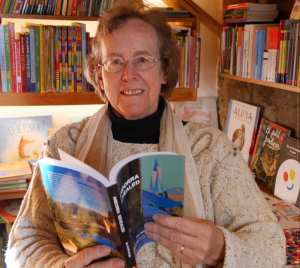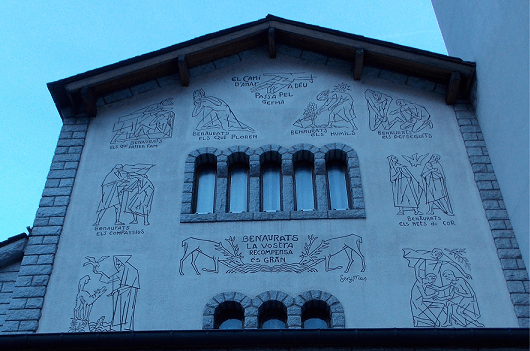 THE BACKGROUND TO MERITXELL DAY
THE BACKGROUND TO MERITXELL DAY
As with many traditions in Andorra (Pyrenees), this one dates back to the Middle Ages, a time of great upheaval all along the northern slopes of the Pyrenees. Christianity and Paganism were fighting for the hearts and minds of the people. Similar legends to that of Our Lady of Meritxell can be found throughout the Pyrenees.
A visit to the Cathedral Museum in La Seu D’Urgell, Catalonia, Spain, ten miles across the border in Spain, will reveal at least eight ‘miraculous’ Madonnas dating from the same period. The original 12th century statue of the Madonna and Child from Canòlich (surrounded by a comparable legend) can be found in the church of San Julia de Loria.
The Legend of Our Lady of Meritxell
It was Three Kings, Epiphany, 6th of January, and very cold. Some people coming up from the direction of Encamp were taking the snow-covered path to Canillo to hear Mass when, to their astonishment, they saw a dog-rose, green-leafed and in full bloom. They drew closer to see what sort of marvel this was and there, under the bush, they found a brightly painted wooden statue of the Virgin and Child. She was 33″ (84 cms) tall. They picked her up and carried her to the priest in Canillo. He put her on the altar and, after Mass, locked the church and went home to bed. The following morning he unlocked the church. And lo! The statue had disappeared.
On taking the path home the pilgrims found to their astonishment that the statue had returned to the foot of the dog-rose. Could it perhaps be that she would prefer to be in Encamp rather than Canillo? They picked her up and carried her carefully down the path to Encamp, handed her to the priest who put her on the altar, locked the door and went home to bed. The next day he unlocked the church and found the statue had disappeared. So the people returned to Meritxell and, lo and behold, they found her yet again under the bush. They then realised that that was where she wanted them to build a sanctuary.
* * * *
After that, the tiny hamlet of Meritxell, first documented in 1176, became a centre of pilgrimage for the whole of the medieval Pyrenees just as modern day pilgrims converge on Lourdes (Occitania, France). There is a fascinating ledger which was kept by the priests, noting down all the gifts given to the Sanctuary including such things as wax candles and a bell rope. Over the centuries, thanks in part to the pilgrims, Canillo became the most prosperous parish in Andorra.
After a request from the Consell General (Andorra’s parliament) in 1913, Pope Pius X gave permission for Our Lady of Meritxell to be declared the Patroness of Andorra. The 8th September was declared a national holiday and the Sanctuary became a symbol of Andorran nationhood. For some 50 years (before the Constitution of 1993 separated church and state), the Síndic, (chairman of the Consell General), gave the State of the Nation address outside the Sanctuary after Mass. He would record the events of the past year and tell of the Council’s plans for the next. After which there would be much traditional sardana dancing and barbeques in the surrounding meadows.
On 8th September, 1972, during the night following the Meritxell celebrations, the old sanctuary mysteriously burnt down. At first it was thought to be an accident and that the 12th century statue had been destroyed. But then it was realised that among the ashes there was no sign of the precious stones that studded her gold crown. It appeared that the statue had been stolen, never to be found, and the fire was an act of arson.
Today the ancient chapel has been simply restored to serve as a museum to the new, imposing Sanctuary of Meritxell, a little forbidding from the outside but bathed in light and superb views from within. Well worth a visit.
To this day people come on foot from all over Andorra and beyond to make their pilgrimage and pay homage to the patroness of Andorra. A friend of mine, along with her son and daughter-in-law will be setting out from Andorra la Vella around dawn next Saturday morning to arrive at the sanctuary on foot for the first Mass of the day.
(Taken from the anthology Andorra Revealed)
Culturally yours,
Clare
_____________
Look for about the author of the blog Clare Allcard
See also Andorra travel guide
See also Pyrenees travel guide
See also France travel guide
See also Spain travel guide










